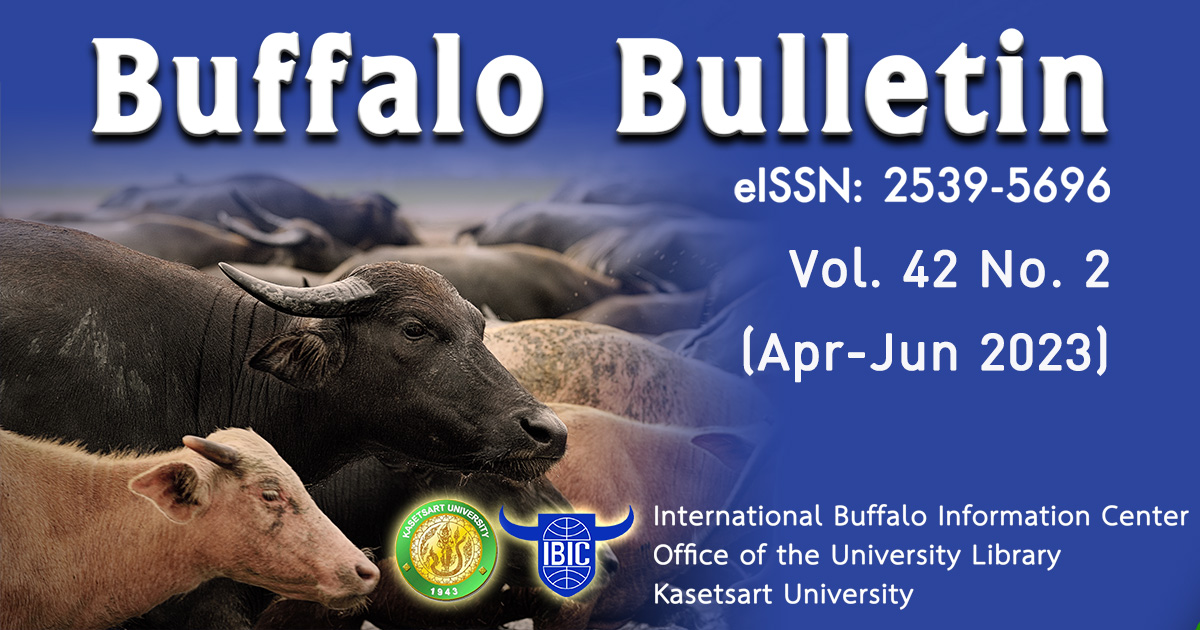Development of ELISA kit for serological diagnosis of Q fever
DOI:
https://doi.org/10.56825/bufbu.2023.4224146Keywords:
Bubalus bubalis, buffaloes, Anatolian buffaloes, cattle, ELISA, goat, Q-fever, sera, sheepAbstract
In this study, it was aimed to develop an ELISA diagnostic kit that can be used in the serological investigation of Q fever disease caused by C. burnetii. For this purpose, bovine, sheep, goat and buffalo sera were tested with a commercial ELISA kit and home-made ELISA kit developed using two different conjugates. Of the 92 buffaloes blood serum samples tested, 22 (23.9%) were found positive by commercial ELISA kit, 7 (7.6%) and 29 (31.5%) were positive by protein-A conjugated ELISA and 29 anti-bovine IgG conjugated ELISA, respectively. In addition, Q fever positive and negative cattle, sheep, and goat blood sera that were found to be positive and negative for Q fever in a previous study conducted on animals with abortion history were also re-examined in our laboratory. In conclusion, within the scope of the project, an alternative homemade ELISA kit was developed for the serological diagnosis of Q fever and serum samples of the target species of buffalo, cattle, sheep, and goats were tested. Thus, the home-made ELISA kit, which can be used in research aimed at detecting seropositivity, especially in buffalo sera, was made ready for use. It was concluded that the data obtained would contribute to wider ranging epidemiological studies. The epidemiology of the disease can be revealed in detail in the light of research to be carried out with more comprehensive projects in our region.
Downloads
Metrics
References
Ahmed, I.P. 1987. A serological investigation of Q fever in Pakistan. J. Pak. Med. Assoc., 37(5): 126-129. Available on: https://www.jpma.org.pk/PdfDownload/5897.pdf
Changoluisa, D., I.A. Rivera-Olivero, G. Echeverria, M.A. Garcia-Bereguiain, and J.H. de Waard. 2019. Serology for Neosporosis, Q fever and Brucellosis to assess the cause of abortion in two dairy cattle herds in Ecuador. BMC Veterinary Research, 15.
Çetinkol, Y., Ö. Enginyurt, B. Çelebi, A.A. Yıldırım, S. Çankaya and O.C. Aktepe. 2017. Investigation of zoonotic infections in risk groups in Ordu University Hospital, Turkey. Niger. J. Clin. Pract., 20(1): 6-11. DOI: 10.4103/1119-3077.181395
Çıkman, A., M. Aydin, B. Gulhan, F. Karakecili, A. Ozcicek, O.A. Kesik, M. Parlak, F. Ozcelik and B. Gültepe. 2017. The seroprevalence of Coxiella burnetii in Erzincan, Turkey: Identification of the risk factors and their relationship with geographical features. J. Vector Dis., 54(2): 157-163.
De Rooij, M.M.T., J.P.G. Van Leuken, A. Swart, M.E.E. Kretzschmar, M. Nielen, A.A. De Koeijer, I. Janse, I.M. Wouters and D.J.J. Heederik. 2019. A systematic knowledge synthesis on the spatial dimensions of Q fever epidemics. Zoonoses Public Hlth., 66(1): 14-25. DOI: 10.1111/zph.12534
Douangngeun, B., W. Theppangna, V. Soukvilay, C. Senaphanh, K. Phithacthep, S. Phomhaksa, S. Yingst, E. Lombardini, E. Hansson, P.W. Selleck and S.D. Blacksell. 2016. Seroprevalence of Q fever, brucellosis, and bluetongue in selected provinces in Lao People’s Democratic Republic. Am. J. Trop. Med. Hyg., 95(3): 558-561. DOI: 10.4269/ajtmh.15-0913
El-Mahallawy, H.S., A.M. Abou-Eisha and H.M. Fadel. 2012. C. burnetii infections in cattle and buffaloes and its public health significance. Suez Canal Veterinary Medicine Journal, 17(2): 51-64.
Galiero, G., C.G. Goffredi and A. D’Orazi. 1996. Epidemiology of Q fever: Seroprevalence in buffalo dairies of Salerno province. Selezione Veterinaria, 6: 407-412.
Gülhan, T., M. Tütüncü, M. Güzel, M.G. Sezener, A. Çiftci, Y. Kılıçoğlu, V.E. Ergüden, S. Akgöz and B. Boynukara. 2019. Serological investigation of Q fever in Anatolian buffaloes. Journal of Anatolian Environmental and Animal Sciences, 4(3): 338-343. DOI: 10.35229/jaes.579953
Gülhan, T., M.G. Sezener, S. Akgöz, V.E. Ergüden, A. Fındık and A. Çiftci. 2020. Molecular characterization of thermophilic Campylobacter species isolated from Anatolian buffalo feces. Journal of Anatolian Environmental and Animal Sciences, 5(1): 86-92. DOI:10.35229/jaes.688263
Günaydın, E. and S. Pekkaya. 2016. Serologic and molecular investigation of Q fever on water buffalo in Afyon. Van Veterinary Journal, 27(1): 17-19. Available on: https://dergipark.org.tr/en/download/article-file/492867
Horton, K.C., M. Wasfy, H. Samaha, B. Abdel-Rahman, S. Safwat, M.A. Fadeel, E. Mohare and E. Dueger. 2014. Serosurvey for zoonotic viral and bacterial pathogens among slaughtered livestock in Egypt. Vector-Borne Zoonot., 14(9): 633-639. DOI: 10.1089/vbz.2013.1525
Kaplan, M.M. and P. Bertagna. 1955. The geographical distribution of Q Fever. B. World Health Organ., 13(5): 829-860.
Karami, M.H., B.M. Pourmahdi, D. Garibi and H.M.R. Haji. 2017. Serological survey of Q fever in goats and buffaloes in Ahvaz region using the ELISA method. Vet. Clin. Path., 11(4): 25-35.
Kalema-Zikusoka, G., R.G. Bengis, A.L. Michel and M.H. Woodford. 2005. A preliminary investigation of tuberculosis and other diseases in African buffalo (Syncerus caffer) in Queen Elizabeth National Park, Uganda. Onderstepoort J. Vet., 72(2): 145-151. DOI: 10.4102/ojvr.v72i2.210
Nahed, H.G. and A.A. Khaled. 2012. Seroprevalence of Coxiella burnetii antibodies among farm animals and human contacts in Egypt. Journal of American Science, 8(3): 619-621. Available on: https://www.jofamericanscience.org/journals/am-sci/am0803/082_8392am0803_619_621.pdf
Office International Epizootica, (OIE). 2018. Q-Fever. Office International Epizootica, Available on: http://www.oie.int/animal-health-in-the-world/animal-diseases/q-fever/
Payzın, S. 1953. Epidemiological investigations on Q fever in Turkey. B. World Health Organ., 9: 553-558.
Payzın, S. and S.B. Golem. 2007. Turkey’s Q Fever (Report 1). Turk. Hyg. Exper. Biol., 64(3): 45-59.
Pradeep, J., S. Stephen, P. Pooja, A. Akshayavardhini, B. Sangeetha and P.X. Antony. 2017. Coxiellosis in domestic livestock of Puducherry and Tamil Nadu: Detection of Coxiella burnetii DNA by polymerase chain reaction in slaughtered ruminants. Vet. World, 10(6): 667-671. DOI: 10.14202/vetworld.2017.667-671
Vaidya, V.M., S.V.S. Malik, K.N. Bhilegaonkar, R.S. Rathore, S. Kaur and S.B. Barbuddhe. 2010. Prevalence of Q fever in domestic animals with reproductive disorders. Comp. Immunol. Microb., 33(4): 307-321. DOI: 10.1016/j.cimid.2008.10.006
Vongxay, K., J.V. Conlan, S. Khounsy, P. Dorny, S. Fenwick and R.C.A. Thompson. 2012. Seroprevalence of major bovine-associated zoonotic infectious diseases in the Lao People’s Democratic Republic. Vector-Borne Zoonot., 12(10): 861-866. DOI: 10.1089/vbz.2011.0850
Yadav, M.P. and M.S. Sethi. 1979. Sero-epidemiological studies on coxiellosis in animals and man in the state of Uttar Pradesh and Delhi (India). Int. J. Zoonoses, 6(2): 67-74.









.png)








